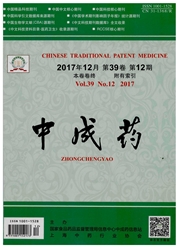

 中文摘要:
中文摘要:
目的探讨对羟基苯甲醛(天麻乙酸乙酯提取物中有效成分)减轻大鼠急性脑缺血损伤后神经炎症的作用并探讨其作用机制。方法采用大鼠颈内动脉注射花生四烯酸诱发多发性脑血栓模型,造模后3 h后处死动物,检测脑内前炎症因子肿瘤坏死因子-α(TNF-α)和白介素-1β(IL-1β)为指标,评价对羟基苯甲醛的脑组织的保护作用;采用脂多糖(LPS)刺激BV-2小胶质细胞复制神经炎症模型,探讨对羟基苯甲醛的抗炎作用机制。结果对羟基苯甲醛能显著降低脑内前炎症因子TNF-α和IL-1β的含有量,降低LPS刺激BV-2小胶质细胞炎症模型细胞上清液中炎症介质NO、前列腺素E2(prostaglandin E2,PGE2)和炎症因子TNF-α的水平,提高正常BV-2小胶质细胞中白介素-10(interleukin-10,IL-10)和转化生长因子-β(transforming growth factors-β,TGF-β)的水平。结论天麻中的对羟基苯甲醛可减轻脑缺血后小胶质细胞过度激活和促进小胶质细胞向抗炎表型转化。
 英文摘要:
英文摘要:
AIM To investigate the anti-neuroinflammation effects of 4-hydroxybenzyl aldehyde( 4-HBAL)from Gastrodia elata Blume on acute cerebral ischemic injury in rats and its mechanism of action. METHODS The rat model of acute cerebral ischemic injury was induced by injecting arachidonic acid via intracarotid artery.Brain tissue samples were taken from the animals 3 h after the model of acute cerebral ischemic injury. Tumor necrosis factor-alpha( TNF-α) and interleukin-1 beta( IL-1β) were detected in brain tissue to evaluate the effects of4-HBAL in vivo. Lipopolysaccharid( LPS)-induced activation of BV-2 microglia cells model was used to explore the anti-neuroinflammation mechanism of 4-HBAL. RESULTS The experimental results showed that 4-HBAL had a significant protective effect on acute cerebral ischemic injury. It could significantly decrease the contents of tumor necrosis factor-alpha( TNF-α) and interleukin-1 beta( IL-1β),and obviously inhibit the production of nitric oxide( NO),prostaglandin E2( PGE2) and TNF-α in LPS-stimulated BV-2 cell,and increase the production of interleukin-10( IL-10) and transforming growth factors-β( TGF-β) in BV-2 cell. CONCLUSION The mechanism of 4-HBAL may be related to the suppression of the excessive activation of microglia after cerebral ischemia and the promotion of the transformation of microglia into anti-inflammatory phenotype.
 同期刊论文项目
同期刊论文项目
 同项目期刊论文
同项目期刊论文
 期刊信息
期刊信息
